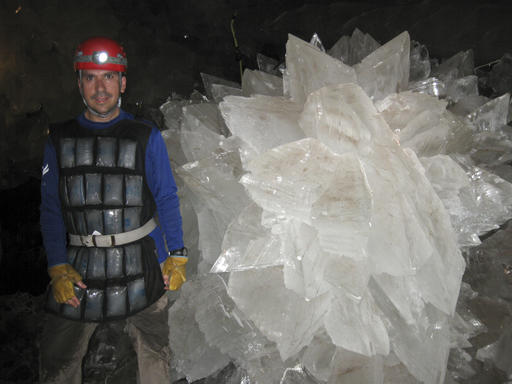
In this image provided by Mike Spilde, Mario Corsalini stands near to a gypsum rosette crystal. In a Mexican cave system so beautiful and hot that it is called both Fairyland and hell, scientists have discovered life trapped in crystals that could be 50,000 years old. The bizarre and ancient microbes were found dormant in caves in Naica, Mexico, and were able to exist by living on minerals such as iron and manganese, said Penelope Boston, head of NASA’s Astrobiology Institute. (Mike Spilde via AP)
BOSTON—Nasa (National Aeronautics and Space Administration) scientists have discovered living microorganisms trapped inside crystals for as long as 60,000 years in a mine in Mexico.
These strange ancient microbes have apparently evolved so they can survive on a diet of sulfite, manganese and copper oxide, said Penelope Boston of Nasa’s Astrobiology Institute in a presentation over the weekend at a conference of the American Association for the Advancement of Science.
“This has profound effects on how we try to understand the evolutionary history of microbial life on this planet,” she said.
They were discovered in the Naica mine, a working lead, zinc and silver mine in the northern Mexican state of Chihuahua.
The mine is famous for its huge crystals, some as long as 50 feet (15 meters).
The discovery has not yet been published in a peer-reviewed scientific journal, but it has led Boston to believe that living organisms may also have survived in the extreme environments of other planets and moons in our solar system.
She said about 100 different kinds of microorganisms — most of them bacteria — have been found locked in Naica crystals for periods ranging from 10,000 to 60,000 years.
Ninety percent of them have never been observed before now, she said.
The discovery of these ultra-hardy microorganisms has been a windfall for researchers but also a source of concern for astrobiologists thinking about bringing back samples collected on space missions in the solar system.
The extreme conditions under which these microbes have survived raises the possibility that dangerous extraterrestrial organisms could accidentally hitch a ride to Earth on a returning spaceship.
Astrobiologists also worry about the risk that Earth organisms could contaminate other planets in the course of missions to places like Mars, which has already been visited by several US robots.
Nasa sterilizes its spacecraft and equipment before launching them into space. But there is always a risk that ultra-resistant microorganisms will survive.
“How do we ensure that life-detection missions are going to detect true Mars life or life from icy worlds rather than our life?” asked Boston.
The concerns are not new. During the Apollo missions of the 1960s and ’70s, astronauts returning from the moon were quarantined.
The microorganisms found in the Naica mine are not even the oldest discovered to date.
Several years ago scientists reported finding microbes in ice and salt that were up to 500,000 years old.